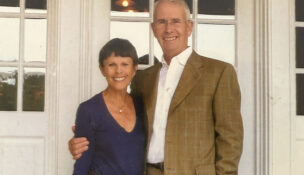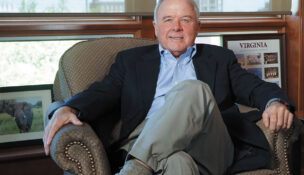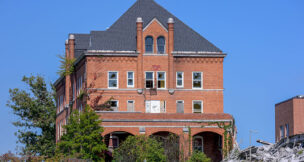
President Bret Danilowicz, Radford University’s eighth president, participates in a 2024 graduate hooding ceremony. Photo courtesy Radford University

President Bret Danilowicz, Radford University’s eighth president, participates in a 2024 graduate hooding ceremony. Photo courtesy Radford University
Radford University enrollment rockets after rebrand
Summary:
- Radford University saw 20% undergraduate enrollment growth in 2024
- School rebranded and refocused recruitment on local high schools
- Commuter students now make up 41% of undergraduates
By recruiting at local high schools, emphasizing its affordability and giving itself a timely rebrand focused on its regional roots, Radford University has surpassed what many other schools have struggled to do: It significantly increased its enrollment in a single year.
In fall 2024, Radford enrolled 6,161 undergraduates, up from 5,074 the previous fall — a whopping 20%. President Bret Danilowicz hopes to keep the trend going this year and beyond.
Last year’s enrollment growth marks a turnaround for Radford, which experienced eight years of declining numbers and was one of three public Virginia universities named last fall as having “some viability risks” in a Joint Legislative Audit and Review Commission study. Researchers focused on enrollment, finances and appeal to prospective students, and Radford had the state’s highest loss of enrollment at 29% between 2014 and 2023.
Danilowicz joined Radford in 2022 determined to help the school rebound, and in 2023, the university unveiled its new website with rebranding to focus on attracting more commuter students from around the New River Valley.
“One of the things we did was re-engage with the high schools, the communities, the commuters within range here, to show that we are here for them, and specifically we’re trying to help their communities,” Danilowicz says. “And part of our resurgence in enrollment has been from our region. That’s where a lot of our students have come from.”
Money matters
Affordability is another major selling point for Radford, Danilowicz adds. “We leaned into our very hands-on experiences [with] students in the classroom, that we’ve got a very small student-to-faculty profile. We really leaned into being an affordable institution.”
Also, he notes that Radford ranks high on the State Council of Higher Education for Virginia’s list of the most affordable four-year public institutions in the commonwealth.
“We are the fourth most affordable in the commonwealth of Virginia, but we’re only out of third place by a little over a hundred dollars,” Danilowicz says, and over the past five years, other four-year schools have raised their tuitions by 3% to 5%, while Radford’s increases have remained below 2% over the past two years.
“The governor has been saying we don’t want institutions to exceed 2.5% [increases] in tuition, some have still exceeded that. We have not. We are purposefully trying to reduce costs.”
In response to the JLARC study, Danilowicz wrote a letter to JLARC’s director saying that he believed his university deserved a designation of “low risk,” and that the agency’s methodology could be improved by including new transfer students as well as first-year students.
While more students are considering return on investment of attending four-year college, Danilowicz notes that in-state students pay an average of $12,952 in tuition each year at Radford, as opposed to $25,575 for tuition, fees and room and board.
“Our room and board is a little over $12,000 a year, it ranges up to $19,000 with some of the institutions in the state. It’s a wide range,” Danilowicz says. “But if you commute to the institution, you don’t have to pay that. So, when people look at affordability, they often see the bundled tuition, room and board all together, and they say that’s a big price tag. Part of regionalism is if people can commute to Radford from within an hour, suddenly you’re looking at [a decrease] of $12,500, before we’ve given any support.
“So it’s $50,000, more or less, over four years to get a degree. People start saying, ‘I can see how that works.’”
Last fall, the Radford Tuition Promise launched for in-state students with $100,000 or less in household income. If they are full-time undergraduate students — new, transfer or returning — they are eligible for the program, which pays full tuition.
It’s a “purposeful commitment which started this past fall … where we re-bundled our financial aid and we made the commitment for any student that attends Radford University from the commonwealth of Virginia,” Danilowicz says. Students still must pay for room and board and certain fees, but the program represents a significant cost savings for many.
“As I tell students and their parents, if you work a part-time job over the course of the year and the summer, and you qualify for that Radford Tuition Promise, you won’t have any expenses by the time you graduate,” Danilowicz says. “You’ll have covered your full costs. You’re not borrowing money from your parents, there’s no loans, so higher education can be very affordable for students. A part of that is being willing to commute to the institution rather than living on campus.”
As a result, about 41% of all undergraduates in the 2024-25 academic year commuted. Danilowicz says that this has become a key point in Radford’s recruitment efforts at area high schools, which he has personally engaged in.
“I went to the regional high schools — part of a big network — and met with families and students in the evenings,” he says. “Just getting us back out there personally. I tend to be a very personable individual. So for us in this area, because it is more rural, people are more ready for personal connections. [My] being at these institutions was part of this messaging.”
That was a change from pandemic-era recruitment meetings that necessarily took place virtually and then continued that way even after shutdowns lifted.
“That had been a trend for a while,” Danilowicz says. “We pulled it almost all back from virtual and put it back in person. So, our recruiters were almost all back in person, traveling to visit students in their space.”
Another significant change at Radford was to focus less on recruiting out-of-state students, who bring in more tuition money but require expensive marketing efforts. In recent years, Danilowicz says, Radford had “been building more and more marketing out of state. And I get that, but that’s an expensive proposition. We’re an in-state institution, our service is to the state, so we pulled back in almost all that out-of-state expenditure and kind of redoubled our marketing here in the area. We put up regional billboards for the first time in a long time.”
Radford also made its athletic teams much more visible in its recruiting efforts. In May, the university announced it would launch a new men’s indoor and outdoor track and field program as NCAA Division I programs, and discontinue men’s and women’s tennis programs. Women’s flag football will start as a club sport this fall, and possibly become a varsity program later.
Apart from its rebranding and targeted local recruitment efforts, Radford has recently won awards that help attract students, Danilowicz says, including Blue Ridge Outdoors naming Radford its “Top Adventure College” earlier this year. The school won a bracket-style popular vote competition, highlighting its location near the Jefferson National Forest, the Appalachian Trail and the New River, as well as group exercise classes held outdoors. It also was named a 2025-26 military-friendly school by Viqtory, an advocacy organization for veterans.
“We are proud to continue to serve our military-affiliated students, help grow that population and receive this recognition,” says Bill Wilson, director of Radford’s Military Resource Center.
Furthermore, guidance counselors, school superintendents and principals have been invited to campus over the past couple of years, Danilowicz says. “Again, that was trying to re-engage them with the university.”
Radford also took a cue from a partnership between George Mason University and Northern Virginia Community College that allows a “seamless transfer process” for graduates of NOVA’s advanced two-year program continuing their education at Mason.
In 2024, Radford launched the “Tartan Transfer Program” with nine nearby community colleges to ease the transfer process for area students.
“When a student signs up to attend Virginia Highland Community College, and they say they’re interested in Radford University, they’ll be able to attend Radford University events, they have another layer of advising that’s also aligned with Radford University, [and] all of their classes will be able to transfer here, so there’s no loss of credit,” Danilowicz explains. “We’re trying to help them feel like they’re part of the Highlander community here before they’ve even graduated from Virginia Highlands.”
Local engagement
The Hub at Radford, meanwhile, helps keep the university engaged in its city. Founded in 2023, the economic development support center is based in downtown Radford and works with local businesses.
“It has several purposes, but one of them is to link businesses to our students and faculty as a talent base,” Danilowicz says. “Part of it is internships; part of it is helping businesses with the projects they struggle with, to get the talent and encouraging our students to stay there once they graduate.”
Like many rural regions, the New River Valley has a “big issue” in keeping a healthy talent pipeline for regional employment, and Radford has a stake in this battle, Danilowicz says.
“Our faculty and many of our departments want to work with businesses and help solve problems for them. They want to take a real-world problem from that company and actually work with their classes on it. That’s not a charge, that’s a free service.”
Meanwhile, students gain experience that could help them find their future careers, he notes. “It’s a complete win-win for us.”
Radford also is less vulnerable to cuts in federal funding, a serious situation for other universities, Danilowicz says. Unlike other Virginia higher education institutions with major research facilities — among them the University of Virginia, Virginia
Tech and George Mason, which are classified R-1 for the number of doctoral degrees they award annually — Radford is less reliant on federal grants and indirect benefits, Danilowicz notes.
“We’re an institution that is focused on education and the research experience … but we haven’t built it around grants,” he says. “For example, 76% of our students graduate having conducted undergraduate research here. That is a really huge number, it is a colossal number. Yet we don’t have the grant infrastructure. We’re largely resilient to the change. It doesn’t change how we teach, the purpose of our teaching.”
Also, Radford has never used race-based or legacy admissions processes, Danilowicz says, which meant it didn’t have to adjust much after the U.S. Supreme Court overturned affirmative action in college admissions in 2023, or when Virginia banned legacy admissions in 2024.
Danilowicz says that he feels positive that Radford’s enrollment momentum will continue into the fall semester.
During a university board of visitors meeting earlier in the year, he acknowledged that Radford “had ambitious goals to stabilize enrollment and initially expected to meet those goals by the fall of 2025. That we are ahead of schedule and exceeded our new student enrollment target by 20% is a remarkable testament to the work that was done across all divisions, and by all our faculty and staff, to continuously raise the profile of Radford University.”
Radford at a glance
Founded
Radford University was established as the State Normal and Industrial School for Women at Radford in 1910. Later called the State Teachers College at Radford, it went coed in 1972 and became Radford University in 1979.
Campus
Set against the Blue Ridge Mountains along the New River, Radford’s 211-acre main campus includes three quadrangles and a pedestrian thoroughfare. Many of its structures are built in a red-brick Georgian style. Radford also operates Radford University Carilion in Roanoke and within the Southwest Higher Education Center in Abingdon.
Enrollment
- Undergraduate: 6,161
- Graduate: 1,651
- In-State: 7,018 (90%)
- Minority: 2,651 (34%)
Faculty
- 422 full-time
Academic programs
Radford has 76 undergraduate degree programs in 47 disciplines — including economics, biology, criminal justice and theater — as well as 28 master’s programs and six doctoral programs, including health-related professions.
Undergraduate tuition and fees
- In-state tuition: $8,648
- Out-of-state tuition: $21,733
- Room and board: $12,060
Statistics are based on fall 2024 data
i
















